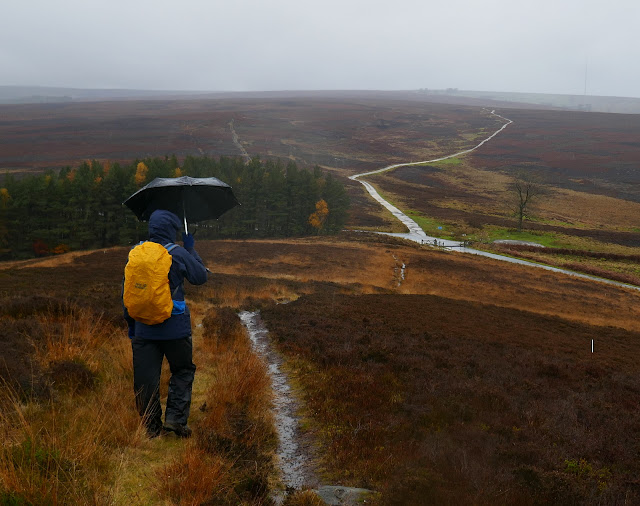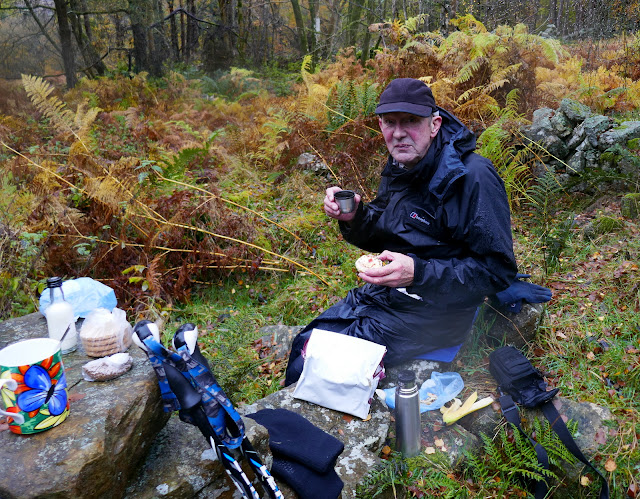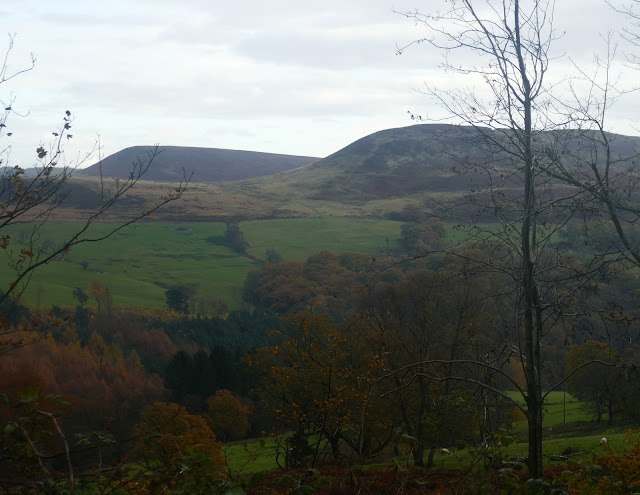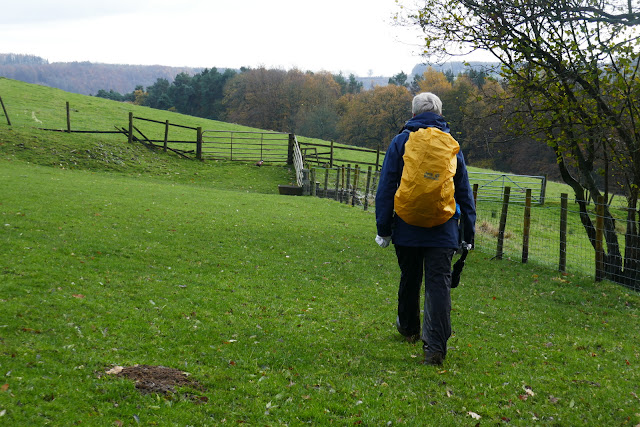Exploring Scugdale from Carlton Bank
7 miles Cold and dull, but dry
We drove up Carlton Bank to the Lord Stones Cafe and parked in their car park, knowing that we would repay their hospitality on our return.
 |
| Today's walk from The Walker's Guide to the Clevelaand Hills |
After booting up we walked back along the Carlton road for a few yards until we reached a new Cleveland Way sign. Here we turned left off the road and almost immediately turned right off the Cleveland Way to follow the wide access road for the old Gliding Club (now demolished) steadily uphill.
 |
| Turn left at the wooden Cleveland Way sign |
 |
| Following the old glider club track uphill |
 |
| We are saluted by geese as we start to climb |
Reaching the moor top we turned left off the access road where a footpath sign indicated our track across the heather. The first feature one comes to on this path is the rocky outcrop of Stone Ruck. Tom Scott Burns explains that Ruck is derived from the Old Norse bruga meaning 'to pile or heap up', as in a cairn.
 |
| Looking left as we climb towards Cringle Moor |
 |
| Wet tracks after recent heavy rain |
 |
| Stone Ruck |
We followed the path for a mile or so across the moor until we came to Brian's Pond which looked dark and uninviting. There was no sign of life in th pond so we continued on our way climbing steadily over Clough Gill Top, where a signpost indicates a choice of routes.
 |
| Brian's Pond |
 |
| Go right at the sign just after the pond |
We took the right fork that ascends steadily to the moor rim where we suddenly came upon the valley of Scugdale. To our right were the rocks of Barker's Crags and below us the buildings of Scugdale Hall.
 |
| Left is Holiday House and centre is Scugdale Hall |
 |
| Panarama showing the whole of Scugdale |
 |
| Barker's Crags |
TSB refers to Scugdale as 'the sheltered dale' from the Danish skygger - to overshadow.
We descended across a couple of fields to reach the dale road where we turned left to walk towards the top of the valley and High House. Over the years the dales road has been strengthened with stones, tarmac, pottery and bricks and we found several old bricks embedded in the lane bearing the name Old Linthorpe.
 |
| We saw several Linthorpe bricks embedded in the road surface |
A google search shows that these bricks were manufactured by a George Grubb Dalton, Brick Manufacturer, Builder & Contractor, Linthorpe, Middlesbrough, who is recorded in the London Gazette as giving Notice of Intended Dividends on the 13th November 1888.
 |
| Descending into the dale... |
 |
| ... to reach the Dale Road that runs from here to Swainby |
We followed the dales road south to reach High House. TSB records that in this old farmhouse lived Harry Cooper who was reputed to be the tallest man in the world, standing at 8'6". He left Scugdale to join Barnum's Circus in America and died in 1898 at the age of 41.
The house is currently unoccupied and its outbuildings falling into ruin. Just beyond the house we turned right off the lane into fields at a dilapidated stile. This part of the walk appears untrodden but there are guiding way-marks at field boundaries and we descended to reach and cross Scugdale Beck where we found (as on our previous visit) the old bridge that continues to serve no useful purpose, having been displaced by winter storms some years ago.
 |
| Approaching High House |
 |
| Unoccupied but by no means a ruin |
 |
| Over the stile at High House... |
 |
| Spoil heaps at the head of Scugdale |
 |
| Descending to Scugdale Beck |
 |
| We have to cross the beck to reach the bridge! |
After crossing the beck we climbed up a steep bank to join the faint path that took us down the valley of Scugdale, walking under old alum workings. When we reached some sheltered grassy banks just before Holiday House Farm we stopped and enjoyed our coffee and scones looking across at Scugdale Hall.
 |
| Walking westwards along the valley |
 |
| Holiday House comes into view |
 |
| Barker's Crag and Scugdale Hall from our coffee stop |









































































































